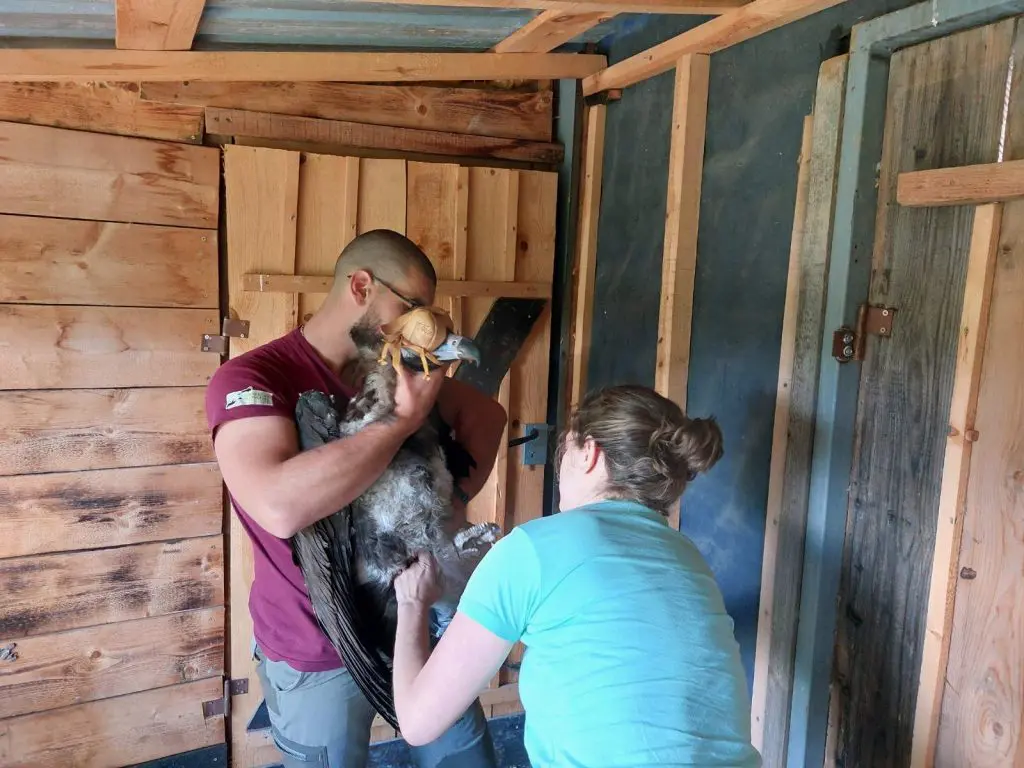
During the summer of 2018, we tagged the first wild Cinereous Vulture nestling in Portugal together with Liga para a Protecção da Natureza (LPN) in the Moura region. Recently, there were no movements from the GPS data, so we carried out an investigation.
Murtigão

Conservationists from LPN and Instituto da Conservação da Natureza e das Florestas (ICNF) identified a young male Cinereous Vulture around 90 days old to be tagged. The team took measurements such as weight from the bird before attaching a ring to him and fitting him with a GPS transmitter, provided by the VCF with funding from the MAVA Foundation. The team named him Murtigão after the river valley he was born on the Herdade da Contenda Estate. Murtigão was one of two Cinereous Vultures that successfully fledged in 2018 from the eight breeding pairs in the area. The colony in Contenda is one of the three now existing in Portugal, following a recent recolonisation from the growing Spanish colonies nearby. Thanks to the GPS transmitter, we were able to track his movements since he fledged on the 5th of July, mainly travelling in the area in Spain, but also in the breeding colony in Portugal.

At the end of November 2018, Murtigão was also photographed visiting a supplementary feeding station managed by LPN in the Herdade da Contenda, the area of his fledging. Recently, there were some warning signs indicated by the GPS data.
Lost tag

On the 26th of December, it was detected that the tag was no longer moving and the worst had to be expected. Quick field inspection by both the Portugese partners and the Junta de Andalusia went on site to search for the tag and the bird. It was soon clear that the bird lost the tag and should hopefully still be fine. Only some days later the team managed to collect the tag, which was very well camouflaged in grass and leaves.
It is normal that tags are lost as they all have a breaking point included in the harness. And we are happy that Murtigão is doing fine.
Cinereous Vultures in Portugal
Cinereous Vultures became extinct as breeding species in Portugal in the 1970s, mostly due to the use of poisoned carcasses targeting unwanted predators. An increasing population in Spain saw the species regularly visiting Portugal to forage with the first pair breeding in central Portugal (Tejo Internacional) in 2010 (where now there is a small colony of about 10 pairs), and then in north-eastern Portugal (one single pair). And in 2015 the species recolonised the natural park Herdade da Contenda, and has bred there successfully ever since – there are about 5 breeding pairs there now.
Working for the recovery of Cinereous Vultures
With the recovery of the species in Spain there has been a range of conservation projects supporting the conservation of the Cinereous Vultures in Portugal such as the cross-border LIFE Rupis project in the Douro Canyon. The LPN also led on a multimillion Euro conservation project, Habitat Lince Abutre, which came to an end in 2016 and supported by the EU’s LIFE+ programme. The project established a network of 10 feeding sites and constructed 30 artificial nesting platforms, which were instrumental to the successful breeding of pairs in southern Portugal.
Sign up to our newsletter and never miss any vulture news!








